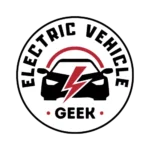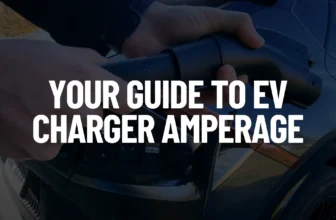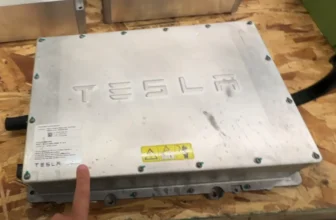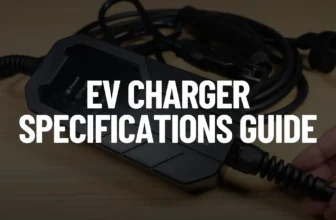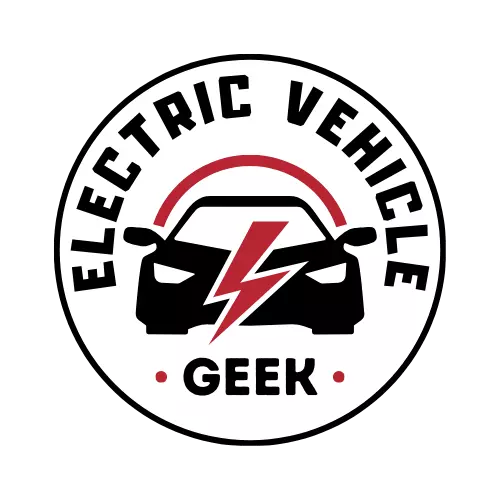In the debate of All-Electric Vehicles vs Hybrid Electric Vehicles, this guide provides a clear comparison between the two. While both reduce emissions and improve fuel efficiency, they have distinct differences as shown in the Illustrative comparison of All-Electric Vehicles vs Hybrid Electric Vehicles showing key components like battery, electric motor, internal combustion engine, gasoline tank, drivetrain, exhaust system, and energy flow directions:
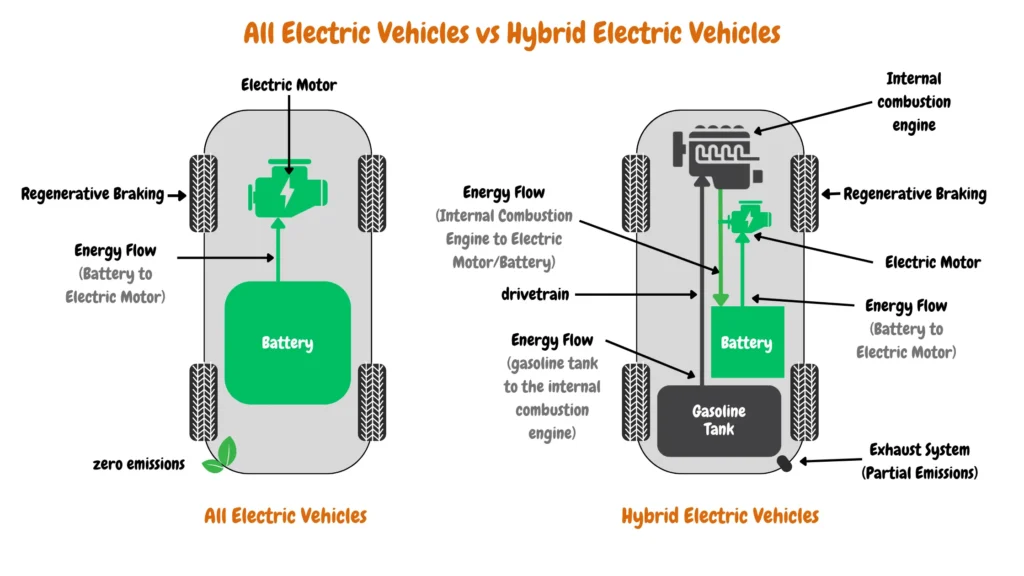
- Power Source: All-electric vehicles are powered solely by electricity, while hybrid electric vehicles use a combination of gasoline and electricity.
- Range: All-electric vehicles typically offer a range of 100 to 400+ miles per charge, whereas hybrid electric vehicles rely on gasoline for extended distances, often exceeding 500 miles combined.
- Charging and Refueling: All-electric vehicles require charging at home or public stations. Hybrid electric vehicles can refuel at gas stations and may also have a charging option if they are plug-in hybrids.
- Emissions: All-electric vehicles produce zero tailpipe emissions, while hybrid electric vehicles emit less than traditional vehicles but more than EVs.
- Maintenance: All-electric vehicles generally have lower maintenance costs due to fewer moving parts. In contrast, hybrid electric vehicles require maintenance for both the electric and internal combustion components.
This guide explores the intricate configurations of all-electric vehicles and hybrid electric vehicles, providing valuable insights even for current EV owners. As experts passionate about electric vehicles, we delve into the deeper aspects of these technologies to enhance your understanding and help you make informed decisions.
Table of Contents
All Electric Vehicles (AEVs)
All-electric vehicles (AEVs) use high-capacity battery packs powering electric motors as their primary power source to propel the vehicle, the vehicle is powered by different energy storage systems such as electric vehicle batteries, Ultracapacitors (UCs), Flywheels, or Fuel Cells.
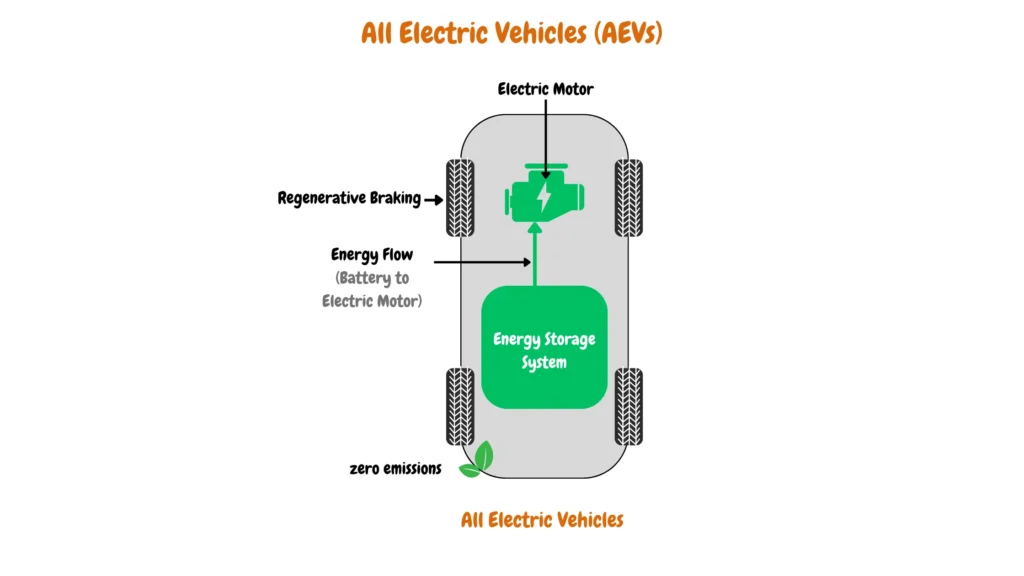
All electric vehicles’ energy source processes allow the vehicle to propel with virtually zero emissions unlike internal combustion engine vehicles (ICEV) that use fuel. Since all-electric vehicles don’t feature an internal combustion engine and other mechanical parts such as mechanical or automatic gearbox the mechanical transmission is eliminated, making all-electric vehicles simple, reliable, and more efficient compared to vehicles with an internal combustion engine.
When we compare the efficiency of an all-electric vehicle using batteries and a vehicle with an internal combustion engine using fuel, an all-electric vehicle achieves more than 90% efficiency compared to 30% efficiency of a vehicle with an internal combustion engine.
Modern electric vehicle vehicles have been able to increase their efficiency by using the latest technologies such as regenerative braking that increase their efficiency even further.
The use of electric vehicle energy storage systems such as batteries has also allowed for quieter electric vehicles compared to vehicles with an internal combustion engine, as the conversion of energy into kinetic energy in electric vehicle batteries has a quieter process compared to the combustion chamber in internal combustion vehicles.
All-electric vehicles (EVs) often qualify for a range of federal, state, and local incentives aimed at promoting clean energy and reducing emissions. These incentives can include tax credits, rebates, reduced registration fees, and access to carpool lanes, making EV ownership more financially attractive. By taking advantage of these benefits, buyers can offset some of the initial costs associated with purchasing an all-electric vehicle, further incentivizing the shift toward sustainable transportation.
Why You Should Buy An All-Electric Vehicle
If you’re concerned about the environmental impact of daily commutes with a traditional gas-powered vehicle, upgrading to an all-electric vehicle is a smart choice. This is especially true if your home is equipped with or soon to integrate renewable energy sources like solar or wind power. By pairing an electric vehicle with solar EV charging or other renewable energy solutions, you can significantly reduce oil consumption, zero fuel consumption, fully electric., and minimize your carbon footprint, making a more sustainable choice for both your finances and the environment.
All electric vehicles feature an efficient and silent electric motor that receives power from its onboard battery propelling the electric vehicle, this process is much quieter compared to the use of an internal combustion engine, which is loud and results in emissions that are harmful to the environment.
All electric vehicles with the latest technology such as regenerative braking are used to feed energy back to the battery when brakes are applied, all electric vehicles such as the new Tesla Cybertruck also feature the latest technologies such as bi-directional EV charging allowing you to feed back energy to your energy storage systems such as Solar batteries, Vehicle to Vehicle (V2V), and also Vehicle to Grid (V2G) further improving the energy efficiency of owning an all-electric vehicles.
Why You Shouldn’t Buy An All-Electric Vehicle
In all-electric vehicles, the battery is the main supply of energy, for this reason, high battery capacities are used that are big, when we discussed the geometry of electric vehicle batteries, we uncovered how additional precautions to fit large batteries in electric vehicles increase the costs of electric vehicles batteries, and battery weight which would affect the electric vehicle dynamics.
Hybrid electric vehicles (HEVs) have smaller battery capacities and smaller electric vehicle batteries compared to all-electric vehicles which makes them cheaper compared to all-electric vehicle batteries, this means that there is better thermal management in hybrid electric vehicles with smaller batteries as smaller batteries offer better heat transfer, especially in lithium-ion batteries.
If you are a person who has range anxiety, an all-electric vehicle is not the best electric vehicle for you, all-electric vehicles have limited range compared to hybrid electric vehicles, purchasing a higher capacity battery might not be the ideal solution as high-capacity batteries are usually bigger adding considerable weight to the vehicle affecting the vehicle dynamics and its driving range.
Another drawback of an all-electric vehicle is that it takes a long to recharge its battery, with a good home charger (Level 2 EV Charger) which is how most people charge their electric vehicles, it takes 7 hours to completely recharge the battery, which to some people coming from an internal combustion engine that uses fuel – is a long amount of time.
Hybrid Electric Vehicles (HEVs)
Hybrid electric vehicles (HEVs) on the other hand combine an internal combustion engine with an energy storage system such as a battery as a power source to propel the hybrid electric vehicle.
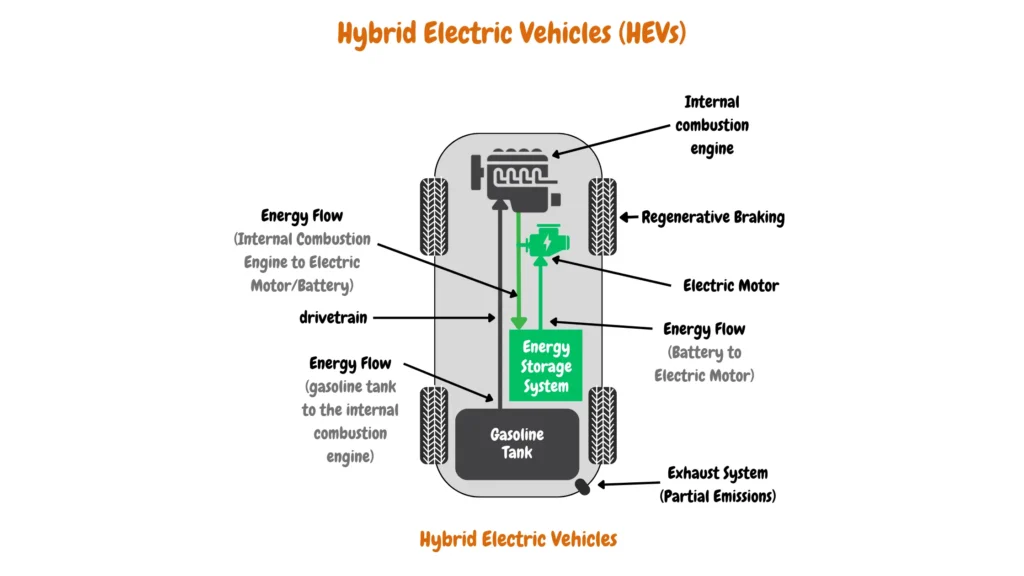
Hybrid electric vehicles are closer to internal combustion engines vehicles we have used for years since they depend on fossil fuel for propulsion, the purpose if additional energy storage systems in a hybrid electric vehicle are mainly used for maintaining the hybrid electric vehicle engine efficiency by avoiding idling, and providing extra power when needed reducing the size of the engine required in hybrid electric vehicles.
Plug-in hybrid electric vehicles (PHEVs) may also be eligible for specific government incentives, similar to their all-electric counterparts. However, traditional hybrid electric vehicles (HEVs) typically do not qualify for the same level of incentives, as they do not operate solely on electric power. While PHEVs can benefit from certain rebates and tax credits, the lack of incentives for standard hybrids highlights the greater emphasis on fully electric solutions in current government policies aimed at reducing greenhouse gas emissions and promoting cleaner technologies.
Types of Hybrid Electric Vehicles (HEVs)
| Type of HEV | Description | Key Features |
|---|---|---|
| Parallel Hybrid | Both the internal combustion engine and electric motor can drive the vehicle simultaneously or independently. | Assists during acceleration Efficient at high speeds |
| Series Hybrid | The internal combustion engine acts as a generator to produce electricity for the electric motor. | Engine not directly connected to wheels Efficient at low speeds |
| Plug-in Hybrid (PHEV) | Can be charged using an external power source, offering a longer electric-only driving range. | Larger batteries Electric-only mode for short commutes |
| Mild Hybrid | Uses a smaller electric motor to assist the internal combustion engine without powering the vehicle alone. | Boosts acceleration Enables regenerative braking |
| Full Hybrid | Can operate on the internal combustion engine, electric motor, or a combination of both. | Automatic mode switching Short electric-only driving capability |
Why You Should Buy A Hybrid Electric Vehicle
Hybrid electric vehicles can achieve better fuel economy compared to conventional internal combustion vehicles, as they feature both energy storage systems such as batteries and an internal combustion engine which makes the transition easier for individuals used to conventional internal combustion engines transitioning to their first electric vehicle.
A hybrid electric vehicle has an advantage compared to an all-electric vehicle in that with a hybrid electric vehicle you can choose whether the electric motor or the internal combustion engine would provide torque to the wheels, this is useful for energy management in different terrains and driving conditions depending on your vehicle configurations.
For Overlanders like us, switching from a conventional Jeep Wrangler to an electric Jeep 4xe we immediately noticed the upgraded powered system when the vehicle is idling, the hybrid vehicle systems such as the A/C and other systems are powered when the vehicle is idling compared to conventional.
Why You Shouldn’t Buy A Hybrid Electric Vehicle
If you are considering switching to an electric vehicle to reduce your environmental impact by reducing your vehicle emissions, we are sorry to say a hybrid electric vehicle relies heavily on an internal combustion engine which uses fossil fuels to power the vehicle, and as we all know fossil fuels have a high environmental impact compared to the use of electric vehicle batteries in the long run.
Hybrid electric vehicles have a limited electric range compared to all-electric vehicles, and their conventional counterparts, their electric range is usually limited to 40-100kms.
If you’re considering purchasing a hybrid electric vehicle with a high-capacity battery, like a plug-in hybrid (PHEV) to extend its electric-only range, be prepared for a price jump. The inclusion of higher-capacity batteries significantly increases the cost of PHEVs, which are already priced higher than traditional gasoline vehicles. While the added battery capacity offers greater range and improved efficiency, it also drives up the overall purchase cost, making it essential to weigh the benefits against the investment.
Choosing Between Electric Vehicles and Hybrid Electric Vehicles
The choice between electric vehicles (EVs) and hybrid electric vehicles (HEVs) depends on your specific driving needs and sustainability goals. For those seeking an eco-friendly solution without the worry of charging time or range limitations, hybrids—especially plug-in hybrids—can be an appealing option. They offer the flexibility of running on electricity for shorter trips while having a gasoline engine for extended range, which is ideal for varied driving scenarios. However, hybrids typically come with the drawback of having two powertrains, which add weight, reduce fuel efficiency, and increase tire wear compared to fully electric vehicles. On the other hand, EVs provide a cleaner, zero-emissions driving experience, making them the more sustainable long-term choice if you have access to reliable charging infrastructure.

James Ndungu is a certified EV charger installer with over five years of experience in EVSE selection, permitting, and installation. He holds advanced credentials, including certification from the Electric Vehicle Infrastructure Training Program (EVITP) and specialized training in EV charging equipment and installation, as well as diplomas in EV Technology and Engineering Fundamentals of EVs. Since 2021, James has tested dozens of EV chargers and accessories, sharing expert insights into the latest EV charging technologies.
